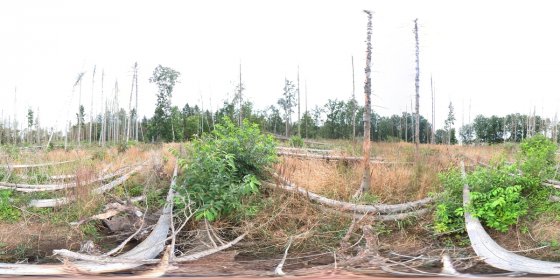VR 360° - Kalamitätsflächen unteres Odertal

Bei dieser Ansicht, handelt es sich um eine barrierefreie Version,
hier geht es zur virtuellen interaktiven 360° Version der Tour 'Kalamitätsflächen unteres Odertal'.
hier geht es zur virtuellen interaktiven 360° Version der Tour 'Kalamitätsflächen unteres Odertal'.
verknüpfte Standpunkte
Area 2.1 Oak /Bottomenthaltene Informationen
History of the area ⇒
<p>A large part of the dying calamity area consists of spruces, oaks and pines, which were presumably planted in the 1970s and 1980s and became part of the national park's inventory after the fall of the Berlin Wall and were thus freed from any use for purely economic purposes (Protection zone 1). </p>
<p><img src="%FIRSTXML%/info/img_9.png" alt="" /></p>
Condition of forest in the Nationalpark ⇒
<p>Currently, the forests in the Lower Oder Valley National Park are under strong pressure. <br /><br />Since 2018, the forest loss has extremely increased. The figure shows the condition of the forest, which is stored around the core zone of the national park. The red areas indicate a total failure of the forest (like the area shown here). The graded discolorations indicate moderate to severe loss of stand vitality. <br /><br />The development shows a drastic decay of the forest areas. Thus the forest in the Lower Oder Valley National Park is massively endangered in its functionality as an ecosystem. The dying of the forest and the accompanying threat of permanent forest loss result in further threats, among others these are: Forest fire, dominance of invasive species, loss of habitats and thus of biodiversity.</p>
<p><img src="%FIRSTXML%/info/img_5.png" alt="" /></p>
Sources ⇒
Area 1
Forest Watch: http://forestwatch.lup-umwelt.de/app/ (01.08.2023)
Area 2.1 Oak /Bottom: Calamagrostis epigejos
Martin Klein (2022): WALDPFLEGE. Hrsg.: Fachagentur Nachwachsende Rohstoffe e. V. https://www.fnr.de/fileadmin/Projekte/2022/Mediathek/Brosch_Waldpflege_RZ_web_neu_final.pdf (01.08.2023)
Area 2.2 Oak /Top: Human-assisted migration
Elena Früchtenicht et al.(2018): Response of Quercus robur and two potential climate change winners—Quercus pubescens and Quercus ilex—.Science Direct. https://www.sciencedirect.com/science/article/abs/pii/S0098847218300091 (01.08.2023)